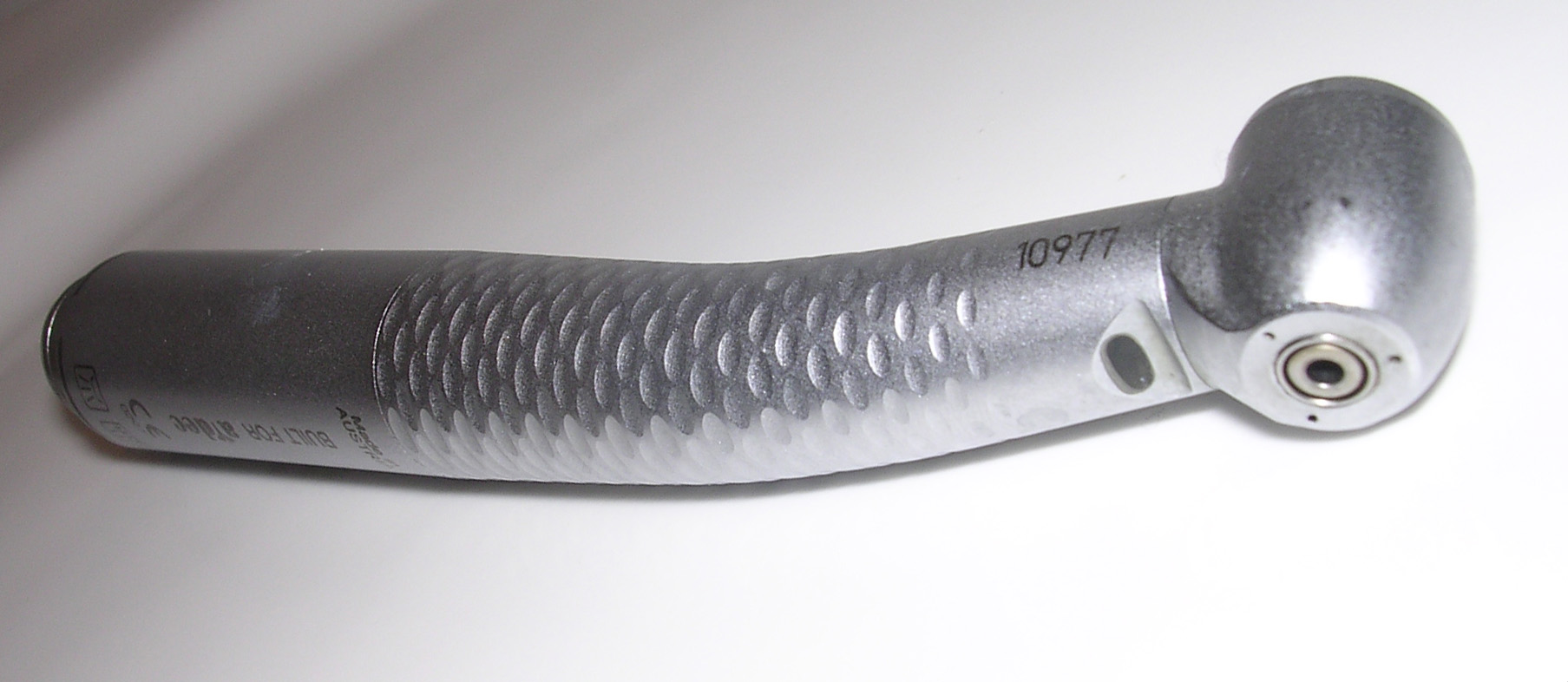Dental drill
Editor-In-Chief: C. Michael Gibson, M.S., M.D. [1]
Overview
|
WikiDoc Resources for Dental drill |
|
Articles |
|---|
|
Most recent articles on Dental drill Most cited articles on Dental drill |
|
Media |
|
Powerpoint slides on Dental drill |
|
Evidence Based Medicine |
|
Clinical Trials |
|
Ongoing Trials on Dental drill at Clinical Trials.gov Clinical Trials on Dental drill at Google
|
|
Guidelines / Policies / Govt |
|
US National Guidelines Clearinghouse on Dental drill
|
|
Books |
|
News |
|
Commentary |
|
Definitions |
|
Patient Resources / Community |
|
Patient resources on Dental drill Discussion groups on Dental drill Patient Handouts on Dental drill Directions to Hospitals Treating Dental drill Risk calculators and risk factors for Dental drill
|
|
Healthcare Provider Resources |
|
Causes & Risk Factors for Dental drill |
|
Continuing Medical Education (CME) |
|
International |
|
|
|
Business |
|
Experimental / Informatics |

A dental drill (or dentist's drill) is a small, high-speed drill used in dentistry to remove decayed tooth material prior to the insertion of a dental filling. Dental drills are used in the treatment of dental caries. The term "dental drill" is considered the more colloquial form of the term "dental handpiece," although it can also be construed as to include to the power source for one or more handpieces, a "dental engine." "Handpiece" and "engine" are more generic and euphemistic terms for generic dental tools.
Modern dental drills can rotate at up to 800,000 rpm, and generally use hard metal alloy bits (actually small rotary files) known as 'burs'. Dental burs come in a great variety of shapes designed for specific applications. They are often made of steel with a tungsten carbide coating, or of tungsten carbide entirely. The bur may also have a diamond coating.
Dental drills, which have a distinctive, shrill sound, are often a prominent factor in many people's fear of dentistry (dentophobia).
History
Archeological researches in the area of the Indus Valley Civilization Mergarh, Pakistan / India, resulted in the finding of eleven human teeth that were treated with flintstone tools.[1] Cavities of 3.5 mm depth with concentric groovings indicate the usage of a drill tool. The age of the teeth has been estimated with 9000 years. In later times, mechanical hand drills were used. Like most hand drills, they were quite slow, with speeds of up to 15 rpm. In 1864, British dentist George Fellows Harrington invented a clockwork dental drill named Erado. The device was much faster than earlier drills, but also very noisy. In 1868, American dentist George F. Green came up with a pneumatic dental drill powered with pedal-operated bellows. James B. Morrison devised a pedal-powered bur drill in 1871.
The first electric dental drill was patented in 1875 by Dr. Green, a development that revolutionized dentistry. By 1914, electric dental drills could reach speeds of up to 3,000 rpm. A second wave of rapid development occurred in the 1950s and 60s, including the development of the air turbine drill.
The modern incarnation of the dental drill is the air turbine handpiece, developed by John Patrick Walsh (later knighted) and members of the staff of the Dominion Physical Laboratory (DPL) Wellington , New Zealand. The first application for a provisional patent for the handpiece was granted in October 1949. This handpiece was driven by compressed air. The final model is held by the Commonwealth Inventions development Board in Canada. The New Zealand patent number is No/104611. The patent was granted in November to John Patrick Walsh who conceived the idea of the contra angle air turbine handpiece after he had used a small commercial type air grinder as a straight handpiece. Dr. John Borden developed it in America and it was first commercially manufactured and distributed by the DENTSPLY Company as the Borden Airotor in 1957.
Current iterations can operate at up to 800,000 rpm, however, most common is a 400,000 rpm "High Speed" Handpiece for precision work complimented with a "Low Speed" Handpiece operating at 20,000 rpm for applications requiring higher torque than a high speed handpiece can deliver. [2]
Alternatives
Starting in the 1990s, a number of alternatives to conventional rotary dental drills have been developed. These include laser ablation systems and air abrasion devices (essentially miniature sand blasters).
Other uses
Dental drills and drill bits are commonly used by jewellers and hobbyists for high-precision drilling work.
References
- ↑ MSNBC, "Dig uncovers ancient roots of dentistry". Page accessed December 24, 2006.
- ↑ Handpiece, Use, Care and Maintenance", Franzel, Mattana. University Detroit Mercy School of Dentistry literature 2007
Additional Resources
- MedTerms definition for Drill, dental
- "Dental drills - enemy of the people?" from the British Dental Association museum
- Australian Dental Journal:1 p59-62
External links
- "Dental More Gentle with Painless 'Drillings' and Matching Fillings", Food and Drug Administration (FDA) Consumer magazine, May-June 1999
- "'Robotic' dental drill to be tested on humans", New Scientist, 20 April 2005
- "Dental Technology and Research", Canadian Dental Association Web Site - (PDF file)
- "History of Dentistry", American Dental Association Web Site
he:מקדחת שיניים
id:Bor gigi
zh-min-nan:Ko-sok chhiú-ki (khí-kho)
Template:Jb1